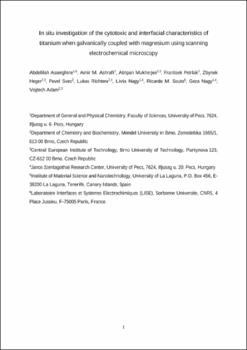In situ investigation of the cytotoxic and interfacial characteristics of titanium when galvanically coupled with magnesium using scanning electrochemical microscopy
Abstract
Recently, the cytotoxic properties of galvanically coupled Mg-Ti particles have been shown to
different cells, although this cytotoxic effect has been attributed mainly to Mg due to its
tendency to undergo activation when coupled with Ti forming a galvanic cell consisting of an
anode (Mg) and a cathode (Ti). However, the role of the Ti cathode has been ignored in
explaining the cytotoxic effect of Mg-Ti particles due to its high resistance to corrosion. In this
work, the role of titanium (Ti) in the cytotoxic mechanism of galvanically coupled Mg-Ti
particles was examined. A model galvanic cell was prepared to simulate the Mg-Ti particles.
The electrochemical reactivity of the Ti sample and the pH change above it due to galvanic
coupling with Mg were investigated using scanning electrochemical microscopy (SECM). It
was observed that the Ti surface changed from passive to electrochemically active when
coupled with Mg. Furthermore, after only 15 min galvanic coupling with Mg, the pH in the
electrolyte volume adjacent to the Ti surface increased to an alkaline pH value. The effects of
the galvanic coupling of Ti and Mg, as well as of the alkaline pH environment, on the viability
of Hs27 fibroblast cells were investigated. It was shown that the viability of Hs27 cells
significantly diminished when Mg and Ti were galvanically coupled compared to when the two
metals were electrically disconnected. Next, the generation of reactive oxygen species (ROS)
increased when the Ti and Mg were galvanically coupled. Thus, although Ti usually exhibited
high corrosion resistance when exposed to physiological environments, an electrochemically
active surface was observed when galvanically coupled with Mg, and this surface may
participate in electron transfer reactions with chemical species in the neighboring environment;
this participation resulted in the increased pH values above its surface and enhanced generation
of ROS. These features contributed to the development of cytotoxic effects by galvanically
coupled Mg-Ti particles.






